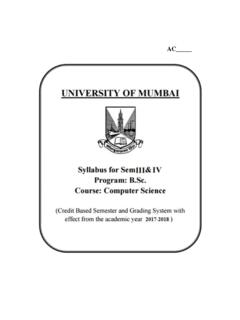Search results with tag "Turing machines"
AC - mu notes
www.munotes.inTuring Machines: Turing Machine Definition, Representations, Acceptability by Turing Machines, Designing and Description of Turing Machines, Turing Machine Construction, Variants of Turing Machine, Undecidability: The Church-Turing thesis, Universal Turing Machine, Halting Problem, Introduction to Unsolvable Problems 15L Tutorials : 1.
UNIVERSITY OF MUMBAI - Vidyalankar Classes
www.vidyalankar.orgDevelop understanding of different types of Turing machines and applications. 4. Understand the concept of Undecidability. Course Outcomes: At the end of the course, the students will be able to 1. Understand concepts of Theoretical Computer Science, difference and equivalence ... “Introduction to Languages and the Theory of Computation”, ...
Turing Machines - University of Georgia
cobweb.cs.uga.eduA Turing Machine M accepts a string w if there exists a sequence of con gurations C 1, C 2, :::C n such that 1. C 1 is the starting con guration of M on input w, 2. C n is an accepting con guration, 3.for each 1 i <n, C i yields C i+1. L(M), language of M (the language recognized by M), is the set of strings accepted by M. CSCI 2670 Turing Machines
Turing Machines: An Introduction
www.seas.upenn.eduEvery recursive language is a recursively enumerable language, but a recursively enumerable language may not be recursive. °c Marcelo Siqueira — Spring 2005. CIT 596 – Theory of Computation 14 Turing Machines: An Introduction In 1900, mathematician David Hilbert enumerated 23mathematical prob-
Turing Machines, diagonalization, the halting problem ...
cs.gmu.eduautomata, there is no speci c halting condition with a Turing machine; the machine is allowed to repeatedly scan the the memory tape, including the input to the computation. The accept and reject states are trap states, and the machine halts its computation if …
When was the first computer invented? - Auckland
www.cs.auckland.ac.nzThe Turing machine was first proposed by Alan Turing in 1936 and became the foundation for theories about computing and computers. The machine was a device that printed symbols on paper tape in a manner that emulated a person following a series of logical instructions.





